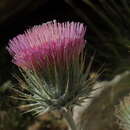en
names in breadcrumbs


Cirsium occidentale, with the common name cobweb thistle or cobwebby thistle, is a North American species of thistle in the family Asteraceae.[3]
Cirsium occidentale is a biennial plant forming a taproot. It may be short or quite tall, forming low clumps or towering to heights approaching 3 meters (10 feet). The leaves are dull gray-green to bright white due to a coating of hairs, and the most basal ones on large plants may be nearly 0.5 m (1+1⁄2 ft) in length.[4] The petioles are winged and spiny and the leaves are toothed or edged with triangular lobes.[5]
The inflorescence at the top of the whitish stem holds one to several flower heads. Each head is sphere-like, covered in large phyllaries with very long, spreading spines which are laced, often quite heavily, in fibers resembling cobwebs.[5]
The head is packed with disc florets which may be white to blood red to shades of purple. The largest flower heads exceed 8 centimeters (3 inches) in diameter.[4] The heads do not open in synchrony, perhaps allowing greater likelihood of being pollinated.[5]
There are several varieties, which differ from each other in range and form:[4]
The plant is widespread and fairly common across most of California: in its mountain ranges, valleys, and the Mojave Desert; and in the western Great Basin region in western Nevada, southern Oregon, and southwestern Idaho.[15][4][16]
Unlike many introduced thistles, this native species is not a troublesome weed.
It is a larval host to the California crescent, mylitta crescent, and the painted lady butterfly.[17]
Cirsium occidentale, with the common name cobweb thistle or cobwebby thistle, is a North American species of thistle in the family Asteraceae.